Analysis of Uber's Competitive Strategies in the Global Market
VerifiedAdded on 2022/09/07
|27
|7404
|30
Report
AI Summary
This report provides a comprehensive analysis of Uber's competitive strategies in the international market. It begins with an overview of Uber, its background, and its operations in over 785 metropolitan areas worldwide. The report outlines the research aim, objectives, and questions, followed by a review of existing literature on Uber's strategies, including customer loyalty, growth models, and competitive advantages. The findings and discussion section delves into Uber's competitive strategies, opportunities, and growth models. The report also provides recommendations for Uber to maintain its market leadership and improve customer retention. The report examines the competitive landscape, strategies for long-term success, and the challenges faced by Uber, such as regulatory issues and competition from other ride-sharing services. The report concludes with recommendations to enhance Uber's market position and competitiveness.
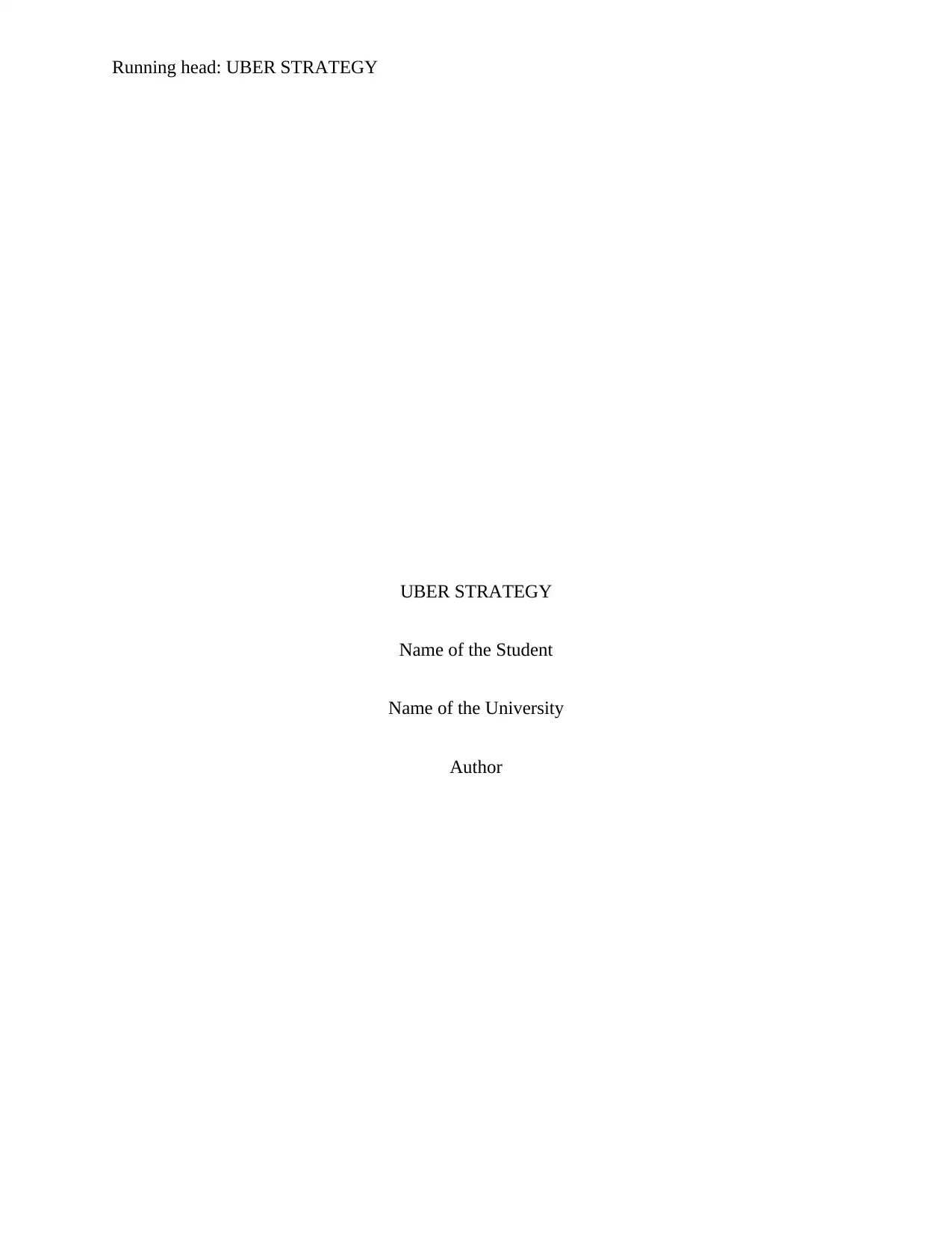
Running head: UBER STRATEGY
UBER STRATEGY
Name of the Student
Name of the University
Author
UBER STRATEGY
Name of the Student
Name of the University
Author
Paraphrase This Document
Need a fresh take? Get an instant paraphrase of this document with our AI Paraphraser
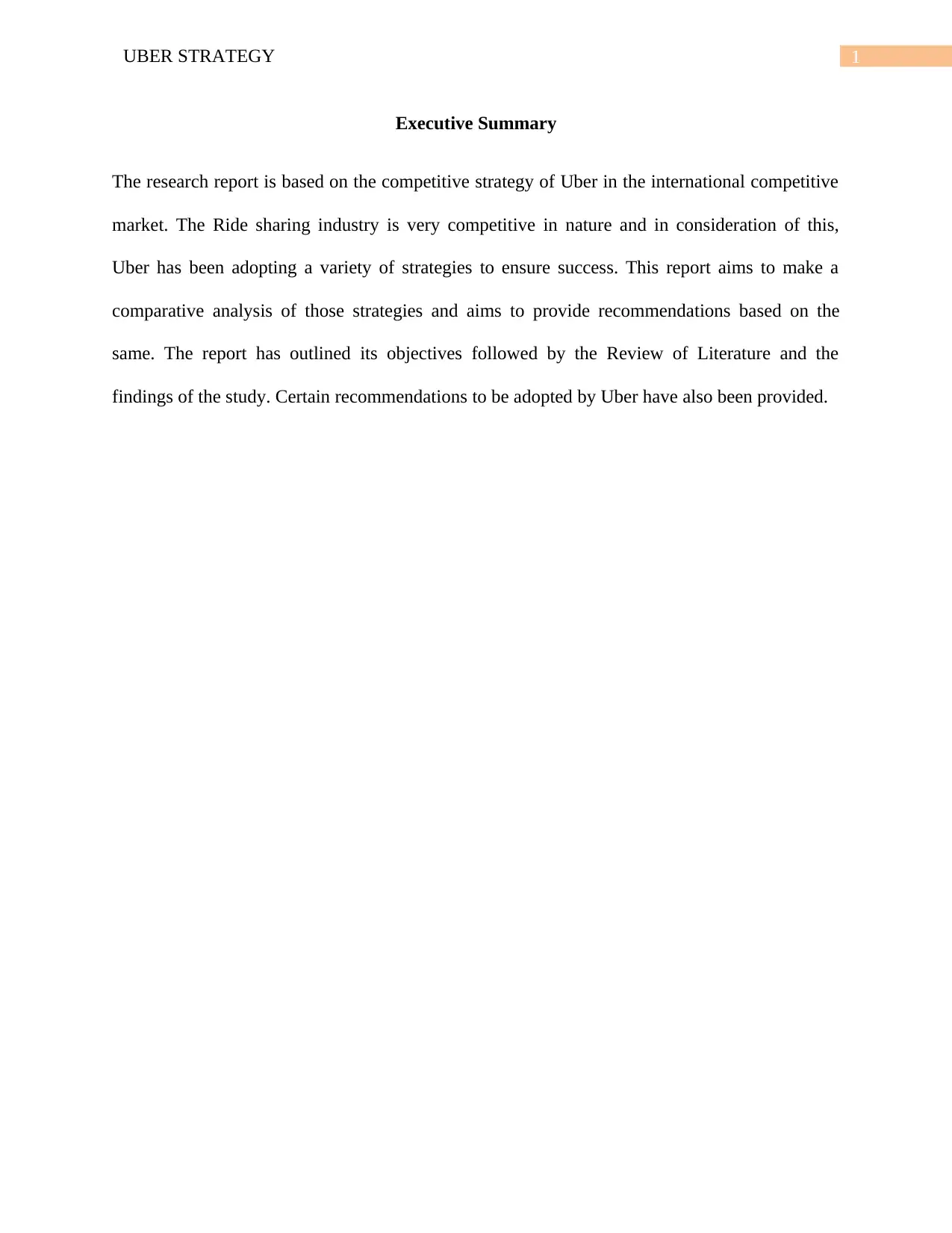
1UBER STRATEGY
Executive Summary
The research report is based on the competitive strategy of Uber in the international competitive
market. The Ride sharing industry is very competitive in nature and in consideration of this,
Uber has been adopting a variety of strategies to ensure success. This report aims to make a
comparative analysis of those strategies and aims to provide recommendations based on the
same. The report has outlined its objectives followed by the Review of Literature and the
findings of the study. Certain recommendations to be adopted by Uber have also been provided.
Executive Summary
The research report is based on the competitive strategy of Uber in the international competitive
market. The Ride sharing industry is very competitive in nature and in consideration of this,
Uber has been adopting a variety of strategies to ensure success. This report aims to make a
comparative analysis of those strategies and aims to provide recommendations based on the
same. The report has outlined its objectives followed by the Review of Literature and the
findings of the study. Certain recommendations to be adopted by Uber have also been provided.

2UBER STRATEGY
Table of Contents
Introduction......................................................................................................................................4
Overview......................................................................................................................................4
Background of the company........................................................................................................4
Research aim................................................................................................................................5
Research Objectives.....................................................................................................................5
Research Questions......................................................................................................................5
Review of Literature........................................................................................................................7
Gaps in the Literature Review...................................................................................................13
Findings and Discussion................................................................................................................14
Competitive Strategies of Uber LLC in the Present Day and Age............................................14
Strategy of Customer Loyalty and Customer Retention............................................................14
Opportunities which lie ahead for Uber.....................................................................................15
Growth Model of Uber..............................................................................................................17
Competitive Business strategy...................................................................................................19
Conclusions and Recommendations..............................................................................................20
Recommendations......................................................................................................................21
Table of Contents
Introduction......................................................................................................................................4
Overview......................................................................................................................................4
Background of the company........................................................................................................4
Research aim................................................................................................................................5
Research Objectives.....................................................................................................................5
Research Questions......................................................................................................................5
Review of Literature........................................................................................................................7
Gaps in the Literature Review...................................................................................................13
Findings and Discussion................................................................................................................14
Competitive Strategies of Uber LLC in the Present Day and Age............................................14
Strategy of Customer Loyalty and Customer Retention............................................................14
Opportunities which lie ahead for Uber.....................................................................................15
Growth Model of Uber..............................................................................................................17
Competitive Business strategy...................................................................................................19
Conclusions and Recommendations..............................................................................................20
Recommendations......................................................................................................................21
⊘ This is a preview!⊘
Do you want full access?
Subscribe today to unlock all pages.

Trusted by 1+ million students worldwide
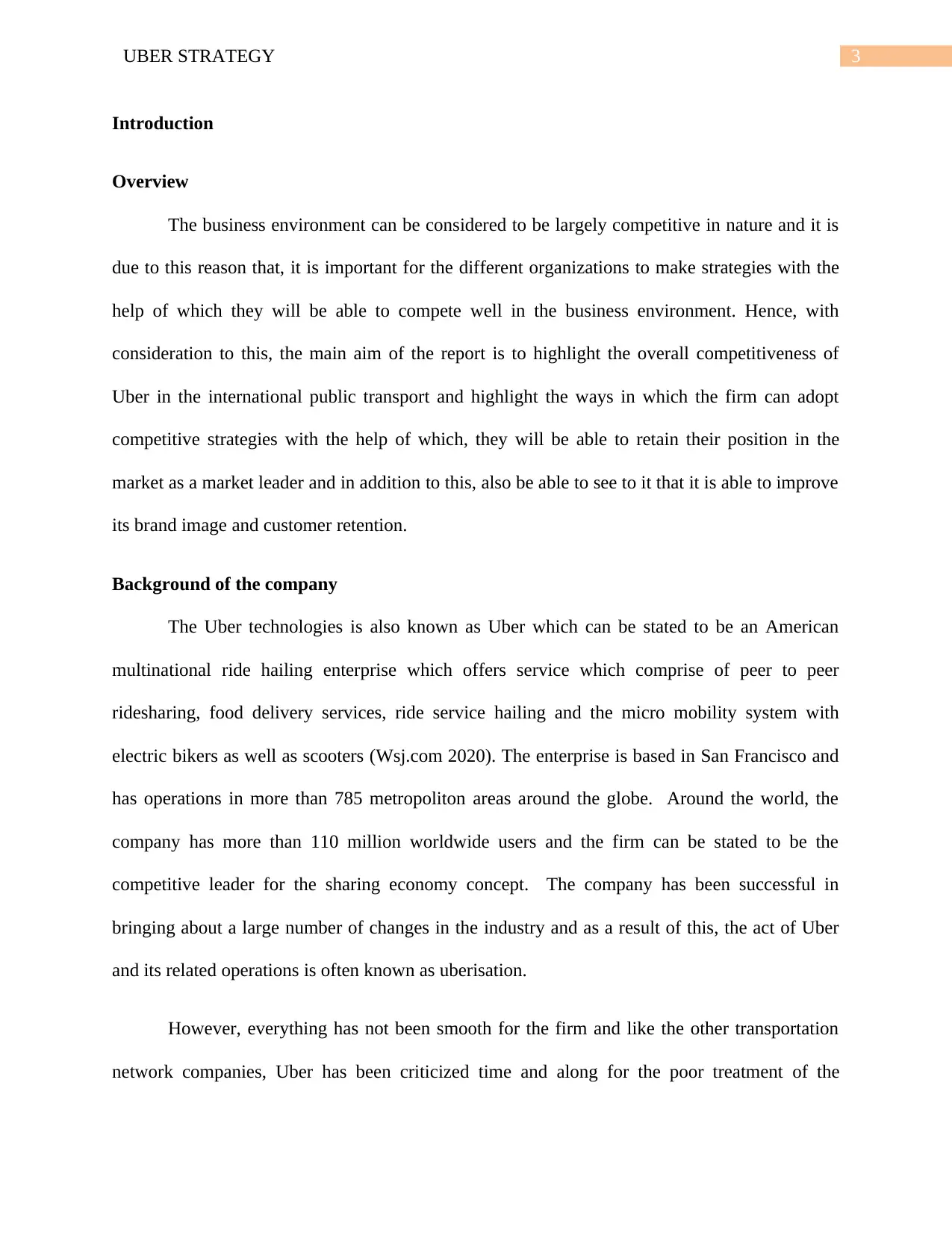
3UBER STRATEGY
Introduction
Overview
The business environment can be considered to be largely competitive in nature and it is
due to this reason that, it is important for the different organizations to make strategies with the
help of which they will be able to compete well in the business environment. Hence, with
consideration to this, the main aim of the report is to highlight the overall competitiveness of
Uber in the international public transport and highlight the ways in which the firm can adopt
competitive strategies with the help of which, they will be able to retain their position in the
market as a market leader and in addition to this, also be able to see to it that it is able to improve
its brand image and customer retention.
Background of the company
The Uber technologies is also known as Uber which can be stated to be an American
multinational ride hailing enterprise which offers service which comprise of peer to peer
ridesharing, food delivery services, ride service hailing and the micro mobility system with
electric bikers as well as scooters (Wsj.com 2020). The enterprise is based in San Francisco and
has operations in more than 785 metropoliton areas around the globe. Around the world, the
company has more than 110 million worldwide users and the firm can be stated to be the
competitive leader for the sharing economy concept. The company has been successful in
bringing about a large number of changes in the industry and as a result of this, the act of Uber
and its related operations is often known as uberisation.
However, everything has not been smooth for the firm and like the other transportation
network companies, Uber has been criticized time and along for the poor treatment of the
Introduction
Overview
The business environment can be considered to be largely competitive in nature and it is
due to this reason that, it is important for the different organizations to make strategies with the
help of which they will be able to compete well in the business environment. Hence, with
consideration to this, the main aim of the report is to highlight the overall competitiveness of
Uber in the international public transport and highlight the ways in which the firm can adopt
competitive strategies with the help of which, they will be able to retain their position in the
market as a market leader and in addition to this, also be able to see to it that it is able to improve
its brand image and customer retention.
Background of the company
The Uber technologies is also known as Uber which can be stated to be an American
multinational ride hailing enterprise which offers service which comprise of peer to peer
ridesharing, food delivery services, ride service hailing and the micro mobility system with
electric bikers as well as scooters (Wsj.com 2020). The enterprise is based in San Francisco and
has operations in more than 785 metropoliton areas around the globe. Around the world, the
company has more than 110 million worldwide users and the firm can be stated to be the
competitive leader for the sharing economy concept. The company has been successful in
bringing about a large number of changes in the industry and as a result of this, the act of Uber
and its related operations is often known as uberisation.
However, everything has not been smooth for the firm and like the other transportation
network companies, Uber has been criticized time and along for the poor treatment of the
Paraphrase This Document
Need a fresh take? Get an instant paraphrase of this document with our AI Paraphraser

4UBER STRATEGY
different drivers, for disrupting the taxi cab services, for the increase in the traffic congestion
and lastly, for the aggressive strategy which Uber generally tends to apply in dealing with
various unlawful practices as well as regulators.
Research aim
The main aim of the research is to outline way in which Uber has been performing in the
international market and additionally, the report also aims to highlight the different strategies
which can be adopted by the firm in order to maintain the competiveness in the long run and to
be able to remain a market leader.
Research Objectives
The objectives which have been set down for the research can be stated to be as follows:
To understand the competitiveness of the Uber as a brand in the international market
To analyze the manner in which the enterprise will be able to adopt various strategies in
order to ensure long term success.
To provide recommendations based on which the firm will be able to perform well in the
future and maintain its market leader and image.
Research Questions
The research questions which have been set down for the paper can be stated to be as
follows:
1. What is the competitiveness position of the Uber as a brand in the international market?
2. What is the manner in which the enterprise will be able to adopt various strategies in
order to ensure long term success?
different drivers, for disrupting the taxi cab services, for the increase in the traffic congestion
and lastly, for the aggressive strategy which Uber generally tends to apply in dealing with
various unlawful practices as well as regulators.
Research aim
The main aim of the research is to outline way in which Uber has been performing in the
international market and additionally, the report also aims to highlight the different strategies
which can be adopted by the firm in order to maintain the competiveness in the long run and to
be able to remain a market leader.
Research Objectives
The objectives which have been set down for the research can be stated to be as follows:
To understand the competitiveness of the Uber as a brand in the international market
To analyze the manner in which the enterprise will be able to adopt various strategies in
order to ensure long term success.
To provide recommendations based on which the firm will be able to perform well in the
future and maintain its market leader and image.
Research Questions
The research questions which have been set down for the paper can be stated to be as
follows:
1. What is the competitiveness position of the Uber as a brand in the international market?
2. What is the manner in which the enterprise will be able to adopt various strategies in
order to ensure long term success?

5UBER STRATEGY
3. What recommendations can be provided based on which the firm will be able to perform
well in the future and maintain its market leader and image?
3. What recommendations can be provided based on which the firm will be able to perform
well in the future and maintain its market leader and image?
⊘ This is a preview!⊘
Do you want full access?
Subscribe today to unlock all pages.

Trusted by 1+ million students worldwide

6UBER STRATEGY
Review of Literature
The strategies that have been undertaken by a company like Uber to establish competitive
advantage in the corporate market have been quite diverse in nature. Vargas-Fernandez et al.
(2018) have undertaken research on the many different strategies which have been adopted and
implemented by Uber in order to stay ahead in the game and in order to keep rivals at bay. It has
been pointed out by the researchers that Uber is a global company which is technology based but
it does not offer any standardized product or service which is why traditional theories pertaining
to competitive rivalry and advantage cannot be applied to the case of Uber, when aiming to see
how it manages to stay ahead of its competitors. A number of new techniques and methods have
been proposed in this respect by Vargas-Fernandez et al. (2018), where they argue that the theory
of institutions needs to be given some importance when analyzing the competitive strategies of
Uber. Apart from merely discussing the strategies and techniques which are made use of by Uber
to win over customers and remain in the good books of its clients, efforts have also been made
on the part of the researchers to analyze the effectiveness of these strategies in an attempt to
understand exactly what it is that makes a business like Uber tick, in the global marketplace. The
emphasis on digitalization and diversification of services are two factors that the researchers
point to as being of key importance for the successful implementation of Uber competitive
strategies worldwide.
Anwar (2017) have made an attempt to study the role or the position that is enjoyed by a
company like Uber in the sharing economy worldwide with a discussion being provided on the
part of the researcher on the types of strategies and techniques that are made use of by Uber in
order to acquire and retain a dominant position in the global sharing economy. It has been argued
Review of Literature
The strategies that have been undertaken by a company like Uber to establish competitive
advantage in the corporate market have been quite diverse in nature. Vargas-Fernandez et al.
(2018) have undertaken research on the many different strategies which have been adopted and
implemented by Uber in order to stay ahead in the game and in order to keep rivals at bay. It has
been pointed out by the researchers that Uber is a global company which is technology based but
it does not offer any standardized product or service which is why traditional theories pertaining
to competitive rivalry and advantage cannot be applied to the case of Uber, when aiming to see
how it manages to stay ahead of its competitors. A number of new techniques and methods have
been proposed in this respect by Vargas-Fernandez et al. (2018), where they argue that the theory
of institutions needs to be given some importance when analyzing the competitive strategies of
Uber. Apart from merely discussing the strategies and techniques which are made use of by Uber
to win over customers and remain in the good books of its clients, efforts have also been made
on the part of the researchers to analyze the effectiveness of these strategies in an attempt to
understand exactly what it is that makes a business like Uber tick, in the global marketplace. The
emphasis on digitalization and diversification of services are two factors that the researchers
point to as being of key importance for the successful implementation of Uber competitive
strategies worldwide.
Anwar (2017) have made an attempt to study the role or the position that is enjoyed by a
company like Uber in the sharing economy worldwide with a discussion being provided on the
part of the researcher on the types of strategies and techniques that are made use of by Uber in
order to acquire and retain a dominant position in the global sharing economy. It has been argued
Paraphrase This Document
Need a fresh take? Get an instant paraphrase of this document with our AI Paraphraser

7UBER STRATEGY
on the part of the researcher that Uber is a business that can not only be regarded as aggressive
and competitive, but which also enjoys quite a distinctive brand image. In the view of Anwar
(2017) what has contributed to the success of the company are the competitive strategies that it
has introduced for this purpose over the years, starting with a sound and effective business
model, the establishment of proper corporate networks and also the introduction of important
labor practices, which at times appear to be quite questionable by virtue of the manner by which
these are put into effect. All in all, as argued by Anwar (2017) the internationalization strategies
of Uber to be a prominent transport company worldwide, have proven to be quite successful, not
only because these have the interests, needs and requirements of the customers at heart but also
because such strategies have been implemented without hesitation, and that a considerable
degree of risk has been undertaken by the Uber management to see the strategies through, after
having envisaged them in the first place. The managerial mistakes, the organizational blunders as
well as the growth hurdles of the company are those which according to Anwar (2017) can be
ignored as these have not come in the way of Uber implementing the best competitive strategies
to stay ahead of its rivals, the most basic strategy in this respect being a strategy that ensures that
the Uber app can be used with convenience by customers, and that it is updated on a regular
basis to ensure that customers can access the latest features that will in turn allow them to hail
cabs, book cab services and use cab facilities with a greater degree of convenience than before.
Collier et al. (2018) have undertaken detailed research on the politics of the Uber
Company in the context of the United States of America with special emphasis being laid on the
part of the researchers on the role that the regulation of disruption has to play in this respect. In
the view of the researchers the platform companies are seen to bring about a disruption not only
in the types of economic sectors that they are seen to enter into but also in the types of regulatory
on the part of the researcher that Uber is a business that can not only be regarded as aggressive
and competitive, but which also enjoys quite a distinctive brand image. In the view of Anwar
(2017) what has contributed to the success of the company are the competitive strategies that it
has introduced for this purpose over the years, starting with a sound and effective business
model, the establishment of proper corporate networks and also the introduction of important
labor practices, which at times appear to be quite questionable by virtue of the manner by which
these are put into effect. All in all, as argued by Anwar (2017) the internationalization strategies
of Uber to be a prominent transport company worldwide, have proven to be quite successful, not
only because these have the interests, needs and requirements of the customers at heart but also
because such strategies have been implemented without hesitation, and that a considerable
degree of risk has been undertaken by the Uber management to see the strategies through, after
having envisaged them in the first place. The managerial mistakes, the organizational blunders as
well as the growth hurdles of the company are those which according to Anwar (2017) can be
ignored as these have not come in the way of Uber implementing the best competitive strategies
to stay ahead of its rivals, the most basic strategy in this respect being a strategy that ensures that
the Uber app can be used with convenience by customers, and that it is updated on a regular
basis to ensure that customers can access the latest features that will in turn allow them to hail
cabs, book cab services and use cab facilities with a greater degree of convenience than before.
Collier et al. (2018) have undertaken detailed research on the politics of the Uber
Company in the context of the United States of America with special emphasis being laid on the
part of the researchers on the role that the regulation of disruption has to play in this respect. In
the view of the researchers the platform companies are seen to bring about a disruption not only
in the types of economic sectors that they are seen to enter into but also in the types of regulatory
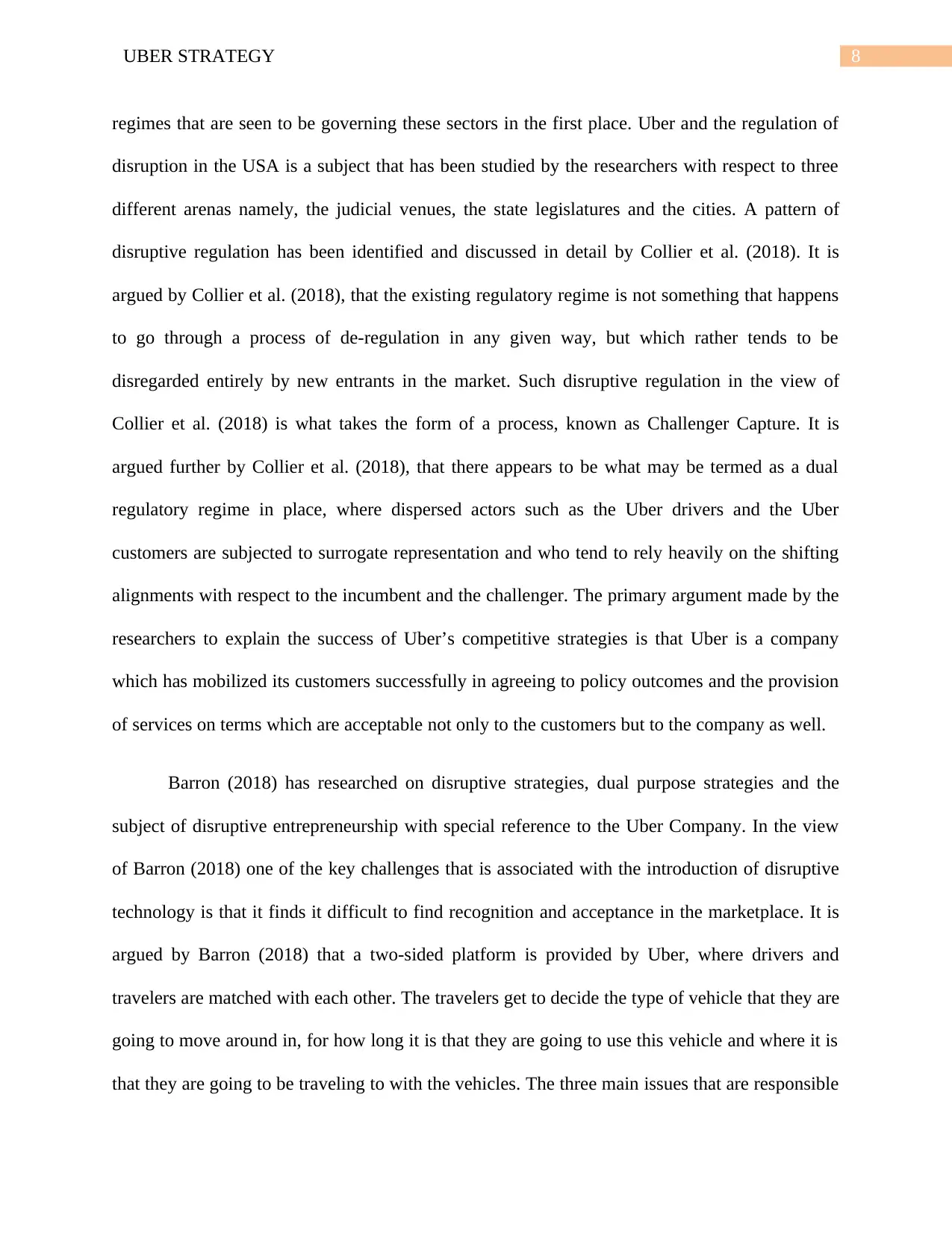
8UBER STRATEGY
regimes that are seen to be governing these sectors in the first place. Uber and the regulation of
disruption in the USA is a subject that has been studied by the researchers with respect to three
different arenas namely, the judicial venues, the state legislatures and the cities. A pattern of
disruptive regulation has been identified and discussed in detail by Collier et al. (2018). It is
argued by Collier et al. (2018), that the existing regulatory regime is not something that happens
to go through a process of de-regulation in any given way, but which rather tends to be
disregarded entirely by new entrants in the market. Such disruptive regulation in the view of
Collier et al. (2018) is what takes the form of a process, known as Challenger Capture. It is
argued further by Collier et al. (2018), that there appears to be what may be termed as a dual
regulatory regime in place, where dispersed actors such as the Uber drivers and the Uber
customers are subjected to surrogate representation and who tend to rely heavily on the shifting
alignments with respect to the incumbent and the challenger. The primary argument made by the
researchers to explain the success of Uber’s competitive strategies is that Uber is a company
which has mobilized its customers successfully in agreeing to policy outcomes and the provision
of services on terms which are acceptable not only to the customers but to the company as well.
Barron (2018) has researched on disruptive strategies, dual purpose strategies and the
subject of disruptive entrepreneurship with special reference to the Uber Company. In the view
of Barron (2018) one of the key challenges that is associated with the introduction of disruptive
technology is that it finds it difficult to find recognition and acceptance in the marketplace. It is
argued by Barron (2018) that a two-sided platform is provided by Uber, where drivers and
travelers are matched with each other. The travelers get to decide the type of vehicle that they are
going to move around in, for how long it is that they are going to use this vehicle and where it is
that they are going to be traveling to with the vehicles. The three main issues that are responsible
regimes that are seen to be governing these sectors in the first place. Uber and the regulation of
disruption in the USA is a subject that has been studied by the researchers with respect to three
different arenas namely, the judicial venues, the state legislatures and the cities. A pattern of
disruptive regulation has been identified and discussed in detail by Collier et al. (2018). It is
argued by Collier et al. (2018), that the existing regulatory regime is not something that happens
to go through a process of de-regulation in any given way, but which rather tends to be
disregarded entirely by new entrants in the market. Such disruptive regulation in the view of
Collier et al. (2018) is what takes the form of a process, known as Challenger Capture. It is
argued further by Collier et al. (2018), that there appears to be what may be termed as a dual
regulatory regime in place, where dispersed actors such as the Uber drivers and the Uber
customers are subjected to surrogate representation and who tend to rely heavily on the shifting
alignments with respect to the incumbent and the challenger. The primary argument made by the
researchers to explain the success of Uber’s competitive strategies is that Uber is a company
which has mobilized its customers successfully in agreeing to policy outcomes and the provision
of services on terms which are acceptable not only to the customers but to the company as well.
Barron (2018) has researched on disruptive strategies, dual purpose strategies and the
subject of disruptive entrepreneurship with special reference to the Uber Company. In the view
of Barron (2018) one of the key challenges that is associated with the introduction of disruptive
technology is that it finds it difficult to find recognition and acceptance in the marketplace. It is
argued by Barron (2018) that a two-sided platform is provided by Uber, where drivers and
travelers are matched with each other. The travelers get to decide the type of vehicle that they are
going to move around in, for how long it is that they are going to use this vehicle and where it is
that they are going to be traveling to with the vehicles. The three main issues that are responsible
⊘ This is a preview!⊘
Do you want full access?
Subscribe today to unlock all pages.

Trusted by 1+ million students worldwide
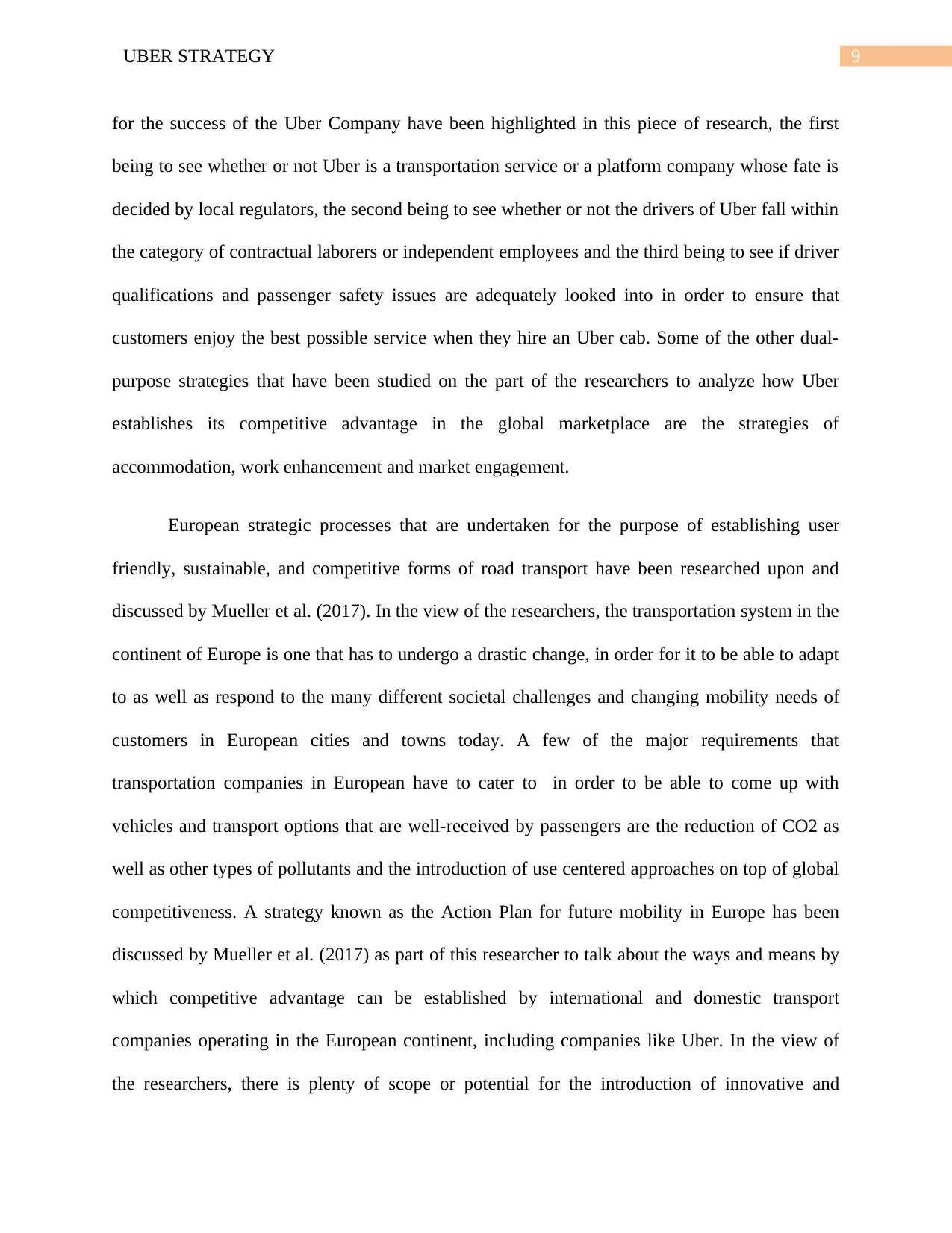
9UBER STRATEGY
for the success of the Uber Company have been highlighted in this piece of research, the first
being to see whether or not Uber is a transportation service or a platform company whose fate is
decided by local regulators, the second being to see whether or not the drivers of Uber fall within
the category of contractual laborers or independent employees and the third being to see if driver
qualifications and passenger safety issues are adequately looked into in order to ensure that
customers enjoy the best possible service when they hire an Uber cab. Some of the other dual-
purpose strategies that have been studied on the part of the researchers to analyze how Uber
establishes its competitive advantage in the global marketplace are the strategies of
accommodation, work enhancement and market engagement.
European strategic processes that are undertaken for the purpose of establishing user
friendly, sustainable, and competitive forms of road transport have been researched upon and
discussed by Mueller et al. (2017). In the view of the researchers, the transportation system in the
continent of Europe is one that has to undergo a drastic change, in order for it to be able to adapt
to as well as respond to the many different societal challenges and changing mobility needs of
customers in European cities and towns today. A few of the major requirements that
transportation companies in European have to cater to in order to be able to come up with
vehicles and transport options that are well-received by passengers are the reduction of CO2 as
well as other types of pollutants and the introduction of use centered approaches on top of global
competitiveness. A strategy known as the Action Plan for future mobility in Europe has been
discussed by Mueller et al. (2017) as part of this researcher to talk about the ways and means by
which competitive advantage can be established by international and domestic transport
companies operating in the European continent, including companies like Uber. In the view of
the researchers, there is plenty of scope or potential for the introduction of innovative and
for the success of the Uber Company have been highlighted in this piece of research, the first
being to see whether or not Uber is a transportation service or a platform company whose fate is
decided by local regulators, the second being to see whether or not the drivers of Uber fall within
the category of contractual laborers or independent employees and the third being to see if driver
qualifications and passenger safety issues are adequately looked into in order to ensure that
customers enjoy the best possible service when they hire an Uber cab. Some of the other dual-
purpose strategies that have been studied on the part of the researchers to analyze how Uber
establishes its competitive advantage in the global marketplace are the strategies of
accommodation, work enhancement and market engagement.
European strategic processes that are undertaken for the purpose of establishing user
friendly, sustainable, and competitive forms of road transport have been researched upon and
discussed by Mueller et al. (2017). In the view of the researchers, the transportation system in the
continent of Europe is one that has to undergo a drastic change, in order for it to be able to adapt
to as well as respond to the many different societal challenges and changing mobility needs of
customers in European cities and towns today. A few of the major requirements that
transportation companies in European have to cater to in order to be able to come up with
vehicles and transport options that are well-received by passengers are the reduction of CO2 as
well as other types of pollutants and the introduction of use centered approaches on top of global
competitiveness. A strategy known as the Action Plan for future mobility in Europe has been
discussed by Mueller et al. (2017) as part of this researcher to talk about the ways and means by
which competitive advantage can be established by international and domestic transport
companies operating in the European continent, including companies like Uber. In the view of
the researchers, there is plenty of scope or potential for the introduction of innovative and
Paraphrase This Document
Need a fresh take? Get an instant paraphrase of this document with our AI Paraphraser
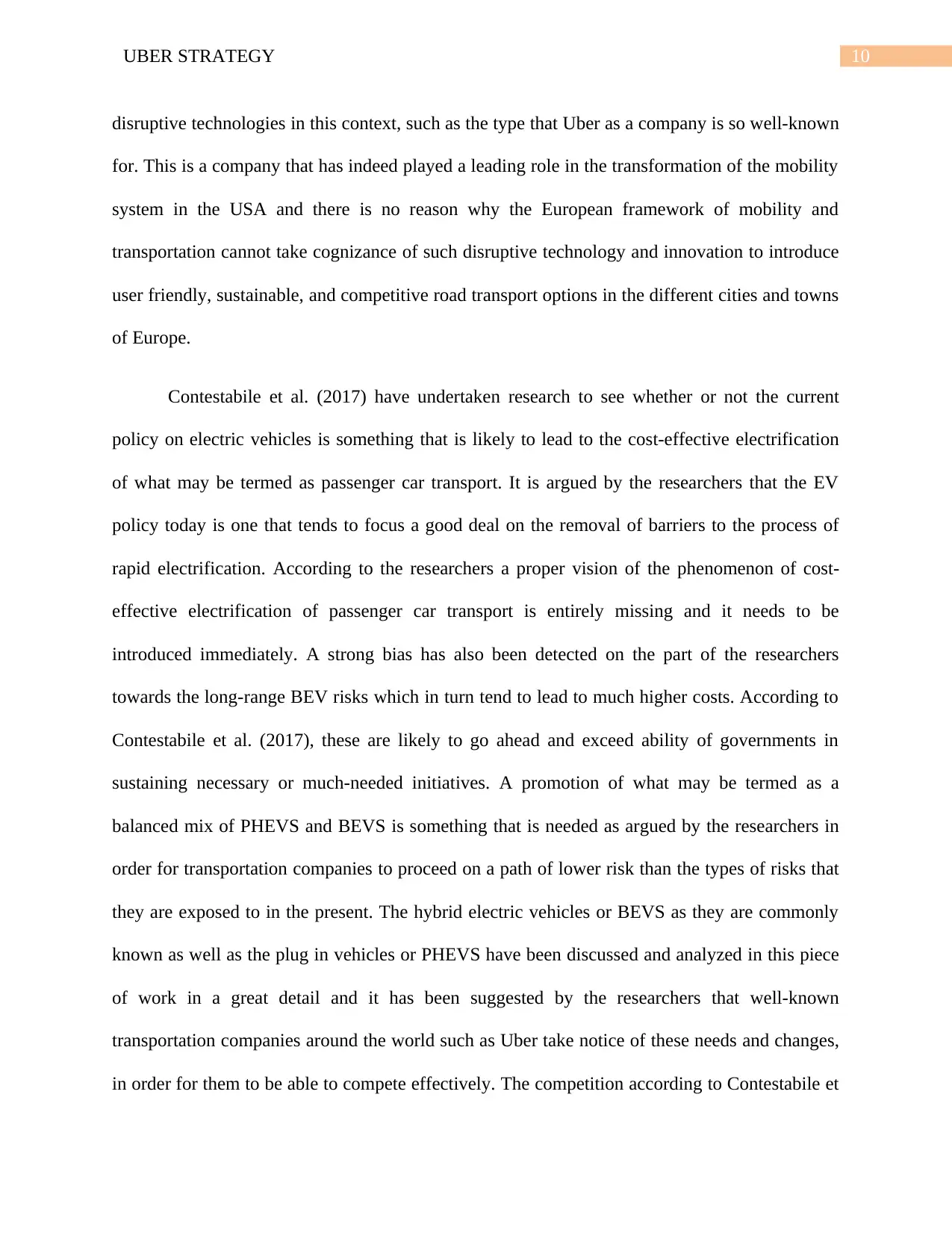
10UBER STRATEGY
disruptive technologies in this context, such as the type that Uber as a company is so well-known
for. This is a company that has indeed played a leading role in the transformation of the mobility
system in the USA and there is no reason why the European framework of mobility and
transportation cannot take cognizance of such disruptive technology and innovation to introduce
user friendly, sustainable, and competitive road transport options in the different cities and towns
of Europe.
Contestabile et al. (2017) have undertaken research to see whether or not the current
policy on electric vehicles is something that is likely to lead to the cost-effective electrification
of what may be termed as passenger car transport. It is argued by the researchers that the EV
policy today is one that tends to focus a good deal on the removal of barriers to the process of
rapid electrification. According to the researchers a proper vision of the phenomenon of cost-
effective electrification of passenger car transport is entirely missing and it needs to be
introduced immediately. A strong bias has also been detected on the part of the researchers
towards the long-range BEV risks which in turn tend to lead to much higher costs. According to
Contestabile et al. (2017), these are likely to go ahead and exceed ability of governments in
sustaining necessary or much-needed initiatives. A promotion of what may be termed as a
balanced mix of PHEVS and BEVS is something that is needed as argued by the researchers in
order for transportation companies to proceed on a path of lower risk than the types of risks that
they are exposed to in the present. The hybrid electric vehicles or BEVS as they are commonly
known as well as the plug in vehicles or PHEVS have been discussed and analyzed in this piece
of work in a great detail and it has been suggested by the researchers that well-known
transportation companies around the world such as Uber take notice of these needs and changes,
in order for them to be able to compete effectively. The competition according to Contestabile et
disruptive technologies in this context, such as the type that Uber as a company is so well-known
for. This is a company that has indeed played a leading role in the transformation of the mobility
system in the USA and there is no reason why the European framework of mobility and
transportation cannot take cognizance of such disruptive technology and innovation to introduce
user friendly, sustainable, and competitive road transport options in the different cities and towns
of Europe.
Contestabile et al. (2017) have undertaken research to see whether or not the current
policy on electric vehicles is something that is likely to lead to the cost-effective electrification
of what may be termed as passenger car transport. It is argued by the researchers that the EV
policy today is one that tends to focus a good deal on the removal of barriers to the process of
rapid electrification. According to the researchers a proper vision of the phenomenon of cost-
effective electrification of passenger car transport is entirely missing and it needs to be
introduced immediately. A strong bias has also been detected on the part of the researchers
towards the long-range BEV risks which in turn tend to lead to much higher costs. According to
Contestabile et al. (2017), these are likely to go ahead and exceed ability of governments in
sustaining necessary or much-needed initiatives. A promotion of what may be termed as a
balanced mix of PHEVS and BEVS is something that is needed as argued by the researchers in
order for transportation companies to proceed on a path of lower risk than the types of risks that
they are exposed to in the present. The hybrid electric vehicles or BEVS as they are commonly
known as well as the plug in vehicles or PHEVS have been discussed and analyzed in this piece
of work in a great detail and it has been suggested by the researchers that well-known
transportation companies around the world such as Uber take notice of these needs and changes,
in order for them to be able to compete effectively. The competition according to Contestabile et
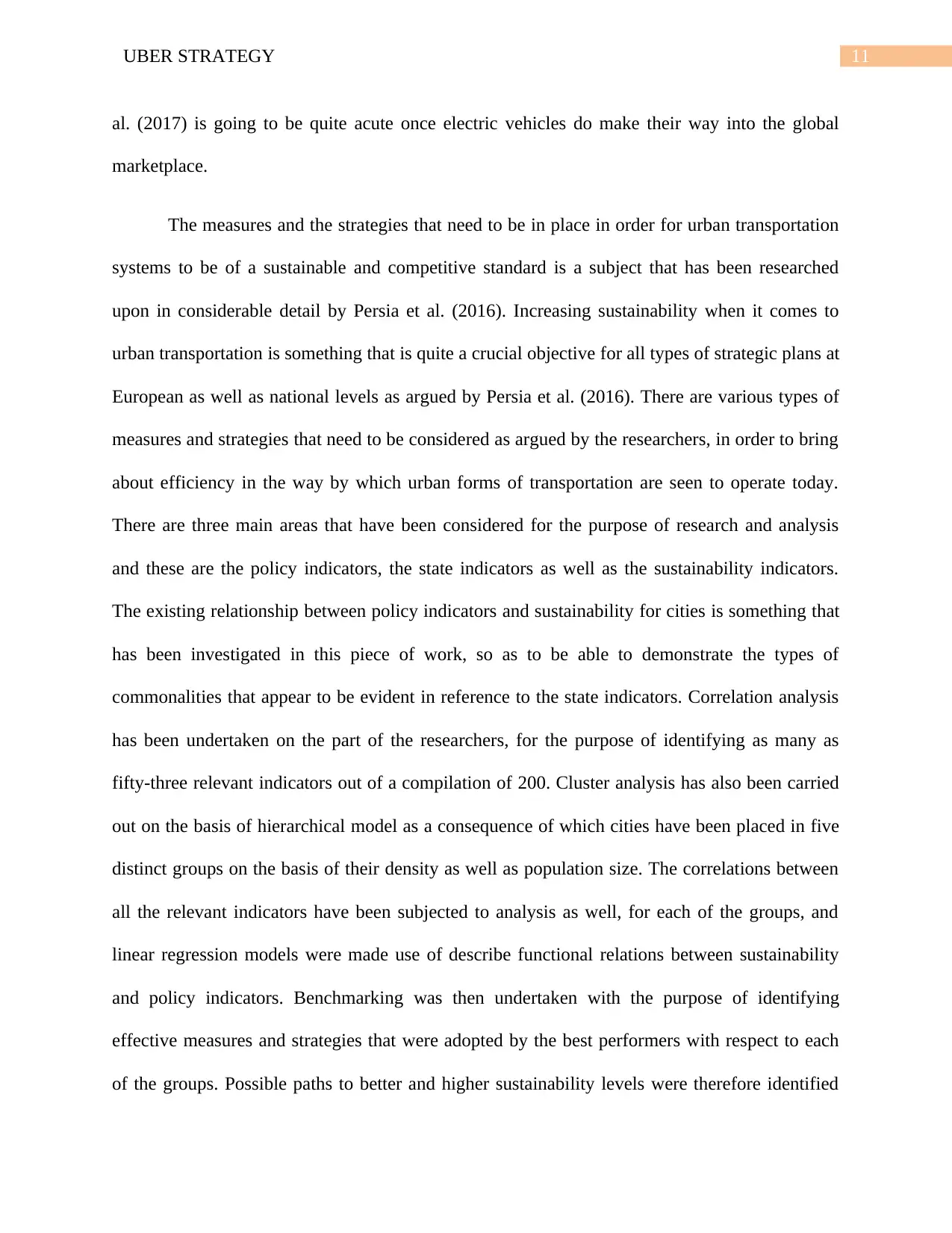
11UBER STRATEGY
al. (2017) is going to be quite acute once electric vehicles do make their way into the global
marketplace.
The measures and the strategies that need to be in place in order for urban transportation
systems to be of a sustainable and competitive standard is a subject that has been researched
upon in considerable detail by Persia et al. (2016). Increasing sustainability when it comes to
urban transportation is something that is quite a crucial objective for all types of strategic plans at
European as well as national levels as argued by Persia et al. (2016). There are various types of
measures and strategies that need to be considered as argued by the researchers, in order to bring
about efficiency in the way by which urban forms of transportation are seen to operate today.
There are three main areas that have been considered for the purpose of research and analysis
and these are the policy indicators, the state indicators as well as the sustainability indicators.
The existing relationship between policy indicators and sustainability for cities is something that
has been investigated in this piece of work, so as to be able to demonstrate the types of
commonalities that appear to be evident in reference to the state indicators. Correlation analysis
has been undertaken on the part of the researchers, for the purpose of identifying as many as
fifty-three relevant indicators out of a compilation of 200. Cluster analysis has also been carried
out on the basis of hierarchical model as a consequence of which cities have been placed in five
distinct groups on the basis of their density as well as population size. The correlations between
all the relevant indicators have been subjected to analysis as well, for each of the groups, and
linear regression models were made use of describe functional relations between sustainability
and policy indicators. Benchmarking was then undertaken with the purpose of identifying
effective measures and strategies that were adopted by the best performers with respect to each
of the groups. Possible paths to better and higher sustainability levels were therefore identified
al. (2017) is going to be quite acute once electric vehicles do make their way into the global
marketplace.
The measures and the strategies that need to be in place in order for urban transportation
systems to be of a sustainable and competitive standard is a subject that has been researched
upon in considerable detail by Persia et al. (2016). Increasing sustainability when it comes to
urban transportation is something that is quite a crucial objective for all types of strategic plans at
European as well as national levels as argued by Persia et al. (2016). There are various types of
measures and strategies that need to be considered as argued by the researchers, in order to bring
about efficiency in the way by which urban forms of transportation are seen to operate today.
There are three main areas that have been considered for the purpose of research and analysis
and these are the policy indicators, the state indicators as well as the sustainability indicators.
The existing relationship between policy indicators and sustainability for cities is something that
has been investigated in this piece of work, so as to be able to demonstrate the types of
commonalities that appear to be evident in reference to the state indicators. Correlation analysis
has been undertaken on the part of the researchers, for the purpose of identifying as many as
fifty-three relevant indicators out of a compilation of 200. Cluster analysis has also been carried
out on the basis of hierarchical model as a consequence of which cities have been placed in five
distinct groups on the basis of their density as well as population size. The correlations between
all the relevant indicators have been subjected to analysis as well, for each of the groups, and
linear regression models were made use of describe functional relations between sustainability
and policy indicators. Benchmarking was then undertaken with the purpose of identifying
effective measures and strategies that were adopted by the best performers with respect to each
of the groups. Possible paths to better and higher sustainability levels were therefore identified
⊘ This is a preview!⊘
Do you want full access?
Subscribe today to unlock all pages.

Trusted by 1+ million students worldwide
1 out of 27
Related Documents
Your All-in-One AI-Powered Toolkit for Academic Success.
+13062052269
info@desklib.com
Available 24*7 on WhatsApp / Email
![[object Object]](/_next/static/media/star-bottom.7253800d.svg)
Unlock your academic potential
Copyright © 2020–2025 A2Z Services. All Rights Reserved. Developed and managed by ZUCOL.





